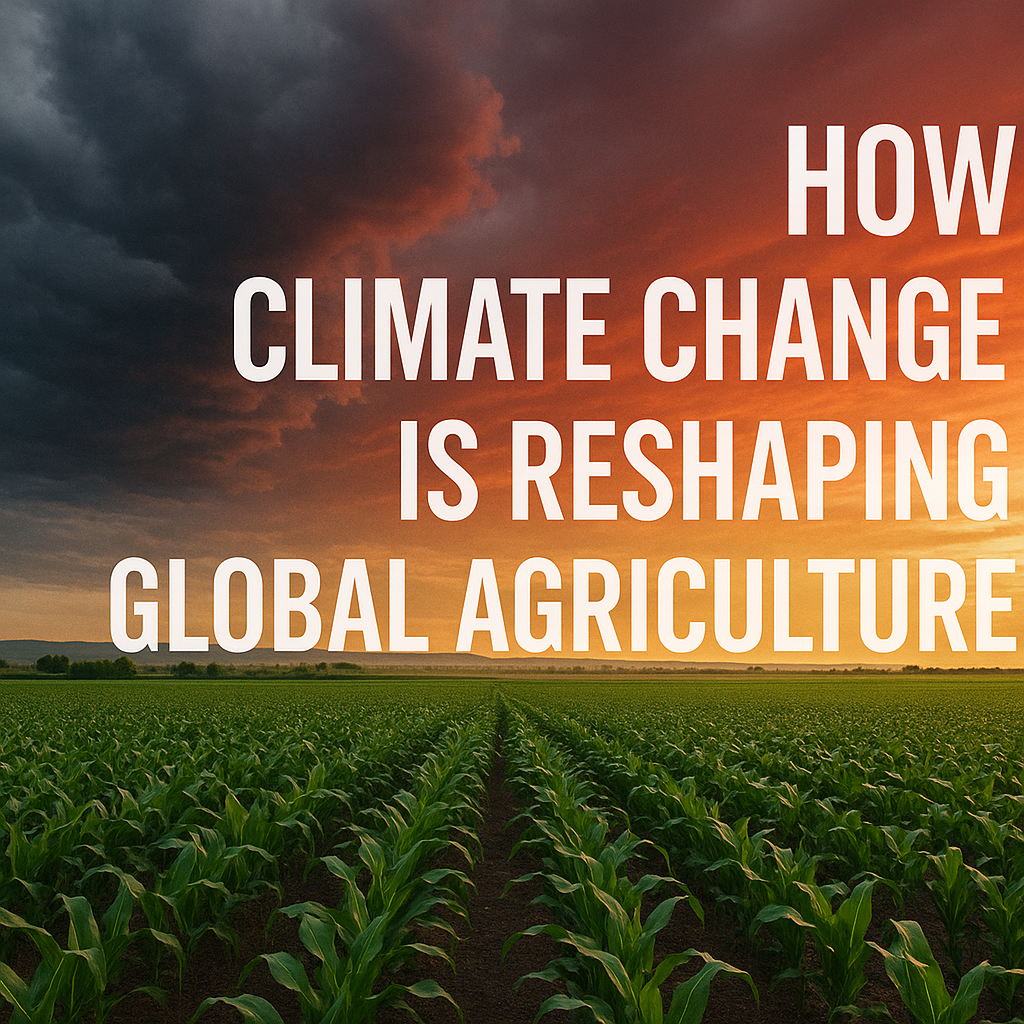Climate change is no longer a distant concern—it’s happening now, and it’s radically transforming how we grow our food. From shifting weather patterns to extreme weather events and soil degradation, agriculture is on the frontline of this global crisis. Farmers, scientists, and governments around the world are racing to adapt as climate change disrupts traditional farming systems and food supply chains. This article explores how climate change is reshaping global agriculture, what it means for food security, and what solutions are emerging.
Rising Temperatures and Their Impact on Crops
One of the most visible consequences of climate change is rising temperatures. According to the United Nations Food and Agriculture Organization (FAO), even a 2°C rise can reduce crop yields in some regions by up to 25%. Heatwaves damage delicate crops like wheat and rice, reducing flowering and fruiting. In tropical regions, coffee and cocoa plants are becoming increasingly unsustainable as temperatures climb.
As crops fail, farmers in vulnerable countries are often left with no safety net. This leads to not just food insecurity, but also migration and economic instability.
Droughts and Water Scarcity
Climate change is intensifying droughts and decreasing freshwater availability, especially in already dry regions. Agriculture consumes about 70% of the world’s freshwater, and this dependency is proving unsustainable. In places like Sub-Saharan Africa and parts of India, farmers are losing entire harvests due to lack of water.
Modern solutions like drip irrigation, aeroponics, and rainwater harvesting are gaining popularity as sustainable alternatives. Countries like Israel are leading the way in smart water technology, offering examples for others to follow.
Flooding and Soil Erosion
While some areas suffer drought, others face increased rainfall and flooding. Torrential rains wash away topsoil, disrupt planting schedules, and destroy storage infrastructure. Soil erosion leads to land degradation and reduced agricultural productivity.
A growing body of research suggests that investing in climate-resilient infrastructure—like elevated seedbeds, reinforced drainage, and agroforestry—can protect farms from these extremes. Visit World Resources Institute for insights on soil preservation and land restoration.
Shifts in Growing Zones and Seasons
Climate change is altering the geography of farming. Crops that once thrived in specific latitudes are now shifting northward or uphill to escape heat and pests. In the U.S., the corn belt is moving north, and vineyards are being established in unexpected regions like the UK and Scandinavia.
While this shift offers new opportunities, it also comes with risks. Newly viable areas may lack necessary infrastructure or face new pest challenges. Farmers must learn new techniques, and governments need to update zoning and insurance policies accordingly.
Increased Pest and Disease Pressure
Warmer temperatures create ideal breeding grounds for pests and plant diseases. According to Nature Climate Change, pest migration is increasing, threatening staple crops in regions that never dealt with such infestations before.
🛡 Powerful Protection Spells That Shield From Harm
Safeguard yourself, loved ones, and your home from negative energy and spiritual threats with effective, trusted protection spells.
This surge in pests puts pressure on chemical pesticide use, which in turn damages ecosystems and human health. More sustainable approaches include biological pest control, intercropping, and the use of AI-driven monitoring tools.
Livestock and Climate Change
The livestock industry is both a victim and a contributor to climate change. Cattle emit methane, a potent greenhouse gas. At the same time, animals are sensitive to heat stress, which reduces milk production and fertility rates.
Innovations such as low-emission feed, rotational grazing, and genetic breeding for heat resistance are helping make animal agriculture more sustainable. Explore IPCC reports on livestock and emissions for more information.
Food Security and Socioeconomic Impacts
As agricultural productivity declines or becomes more uncertain, food prices are likely to rise. This hits low-income populations the hardest. The World Bank estimates that climate-related crop failures could push over 100 million people into poverty by 2030.
Women and smallholder farmers, who make up a significant part of the agricultural workforce in many countries, are disproportionately affected. Governments must prioritize inclusive policies and access to climate finance.
Adaptation Strategies and Innovations
To mitigate the damage and adapt to new realities, several strategies are gaining momentum:
Climate-smart agriculture (CSA): Focuses on increasing productivity, resilience, and reducing emissions.
Genetically modified (GM) crops: Drought and heat-resistant varieties are helping some regions maintain yields.
Vertical farming and hydroponics: Useful in urban areas and climates unsuitable for traditional farming.
Digital agriculture: AI, drones, and remote sensors are transforming how farmers make real-time decisions.
For cutting-edge developments in agri-tech, visit AgFunder News.
Global Policies and Cooperation
Global challenges require global solutions. Agreements like the Paris Climate Accord push nations to reduce emissions and invest in green agriculture. Organizations like CGIAR are working across continents to develop climate-resilient farming systems.
International funding mechanisms, such as the Green Climate Fund (GCF), provide financial support to vulnerable countries developing adaptation solutions.
The Role of Consumers
What we choose to eat has a significant impact on agricultural demand. Embracing plant-based diets, reducing food waste, and buying locally grown produce can help reduce the environmental footprint of agriculture.
The rise of climate labeling on food products is making it easier for consumers to make informed choices. Read UN Environment Programme’s guide to sustainable food systems for practical tips.
Conclusion
Climate change and agriculture are deeply intertwined. While the challenges are immense, so are the opportunities for innovation, resilience, and collaboration. By rethinking how we produce, distribute, and consume food, we can shape a future where agriculture not only survives but thrives in a changing world. For brands, policymakers, and individuals alike, the time to act is now.





